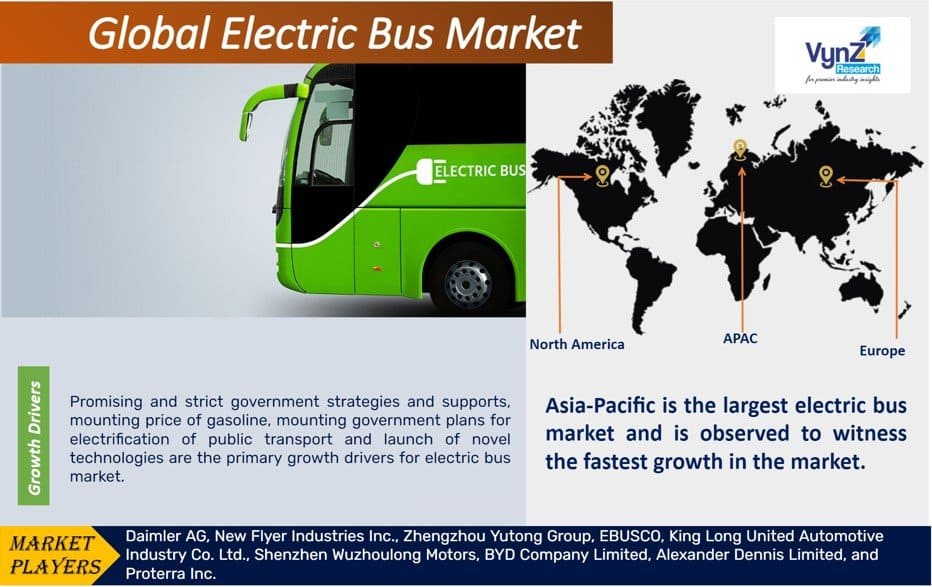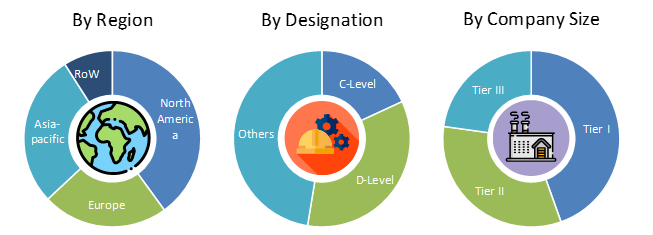Global Electric Bus Market – Analysis and Forecast (2025-2030)
Industry Insights by Vehicle Type (Battery Electric Bus, Hybrid Electric Bus, and Plug-In Hybrid Electric Bus), by Battery (Lithium Iron Phosphate Battery, Lithium Nickel Manganese Cobalt Oxide, and Others) and by Geography (North America,Europe,Asia-Pacific (APAC),Rest of the World (RoW))
| Status : Published | Published On : Mar, 2024 | Report Code : VRAT4014 | Industry : Automotive & Transportation | Available Format :

|
Page : 114 |
Global Electric Bus Market – Analysis and Forecast (2025-2030)
Industry Insights by Vehicle Type (Battery Electric Bus, Hybrid Electric Bus, and Plug-In Hybrid Electric Bus), by Battery (Lithium Iron Phosphate Battery, Lithium Nickel Manganese Cobalt Oxide, and Others) and by Geography (North America,Europe,Asia-Pacific (APAC),Rest of the World (RoW))
Industry Overview
The global electric bus market is growing at 17.2% CAGR during the forecast period, with its fleet size anticipated to reach 283.3 thousand units by 2030. It is projected to reach USD 66.5 billion from USD 19.2 billion in 2023 within the forecast period.
The electric buses do not use fuel to operate and therefore do not emit harmful carbon to pollute the environment. There are different types of such vehicles, such as battery electric buses, hybrid electric buses, and plug-in hybrid electric buses. Though all are equally good, the battery electric buses are more in use and are highly preferred due to the lowering prices of batteries and low amount of carbon emissions.
The growth of this market is driven by favorable government initiatives as well as the growing concern over environmental pollution. Governments all over the globe are supporting the production and use of these vehicles to reduce greenhouse gas emissions. Technological advancements are also propelling the growth of the electric bus market.

Electric Bus Market Segmentation
Insight by Vehicle Type
According to the different types of vehicles, the global electric bus market is divided into battery electric buses, hybrid electric buses, and plug-in hybrid electric buses segments. Out of all these segments, the battery electric buses segment contributes to the larger share and is expected to grow at a faster rate during the forecast period. This is mainly due to the decreasing prices of batteries and lower carbon emissions.
Insight by Battery
According to the battery types, the global electric bus market is divided into lithium iron phosphate battery, lithium nickel manganese cobalt oxide, and other segments. Out of all these segments, the lithium iron phosphate battery segment accounts for the largest share of the market due to higher safety and cost-effectiveness.
However, the lithium nickel manganese cobalt oxide segment is also expected to grow during the forecast period at a faster rate due to lower prices and higher energy density.
Global Electric Bus Market Report Coverage
|
Report Metric |
Details |
|
Historical Period |
2020 - 2024 |
|
Base Year Considered |
2025 |
|
Forecast Period |
2026 - 2035 |
|
Market Size in 2025 |
U.S.D. 19.2 Billion |
|
Revenue Forecast in 2035 |
U.S.D. 283.3 Billion |
|
Growth Rate |
17.2% |
|
Segments Covered in the Report |
by Vehicle Type,by Battery |
|
Report Scope |
Market Trends, Drivers, and Restraints; Revenue Estimation and Forecast; Segmentation Analysis; Impact of COVID-19; Companies’ Strategic Developments; Market Share Analysis of Key Players; Company Profiling |
|
Regions Covered in the Report |
North America,Europe,Asia-Pacific (APAC),Rest of the World (RoW) |
Industry Dynamics
Electric Bus Market Growth Drivers
Several factors drive the growth of the global electric bus market. However, the most significant factor is the rising support for these vehicles by governments across the globe and the rising need for reducing greenhouse gas emissions.
The strategies and support by the governments are both strict yet promising, which drives the growth of this market. The plans of the governments for the electrification of public transport will also induce more electric buses into the system.
Add to that, the rising price of gasoline is also encouraging a shift to electric buses than traditional fuel-based buses.
The advancement in technologies and their launch in addition to the increased need for more efficient vehicles with zero carbon emission also propels the growth of the global electric bus market. The governments are also very strict on vehicle emissions and have imposed several severe regulations, which have also fueled the growth of this market.
Also, over the years there has been a significant increase in air pollution due to the fuel-based buses raising concerns over environmental pollution and negative impacts. This has also contributed to the growth of the global electric bus market.
Some other significant factors that propel the growth of this market are the lower cost of lithium-ion batteries, the development and rise in the number of charging infrastructure, and less maintenance requirements due to less noise.
Electric Bus Market Trends
The major players in the industry all over the globe are launching new products. This is leveraging the growth of the global electric bus market.
A lot of money is invested by the industry players for research and development of better battery technology that will be both energy-efficient and cost-efficient, which will, in turn, lower the cost and enhance the performance of electric buses.
Electric Bus Market Challenges
The lack of standardization, shorter lifecycle of the battery, inadequate charging infrastructure, high manufacturing cost, and stringent rules for the installation of charging stations are the major obstacles to the growth of the electric bus market. However, technological and infrastructural improvements and favorable support by the governments are changing the scenario and facilitating the growth of the global electric bus market.
Electric Bus Industry Ecosystem
Globally industry players are leveraging market growth through launching new products. Different players are investing in the development of new battery technology to lower the cost of electric buses to compete against gasoline buses in terms of price and performance. In the coming years, industry leaders are anticipated to significantly lower the cost of these vehicles and enhance the performance of these vehicles leading to adoption by the masses.
Electric Bus Market Geographic Overview
Asia-Pacific is the largest contributor to the electric bus market. It is also expected to grow at a faster rate during the forecast period due to rising government initiatives and support for these vehicles. In addition, the growing population base in this region along with the increase in air pollution also fuels the need for using these buses.
Furthermore, the growing concern over environmental impact and safety, reducing the cost of batteries, rising disposable income, rapid urbanization, increasing gasoline price, and growing need for zero carbon emission and efficient vehicles, are also fueling the growth of the global electric bus market in this region.
On the other hand, the European market is expected to grow at a higher CAGR during the forecast period due to favorable government policies and increasing efforts in reducing vehicle emissions. Furthermore, governments in this region have also taken initiatives to deploy green transportation technologies in their public transportation system to make it more sustainable and safer, which will push the market further forward.
Electric Bus Market Competitive Insight
Major players in the electric bus market are catering to the demand by collaborating with small players and investing in technologically advanced product portfolios across the globe. In October 2017, Proterra introduced the DuoPower drivetrain for its Catalyst zero-emission buses at the American Public Transit Association (APTA). Daimler AG, New Flyer Industries Inc., Zhengzhou Yutong Group, EBUSCO, King Long United Automotive Industry Co. Ltd., Shenzhen Wuzhoulong Motors, BYD Company Limited, Alexander Dennis Limited, and Proterra Inc. are the key players offering electric bus.
Recent Developments by Key Players
Daimler Buses Solutions (the latest subsidiary of Daimler Buses) shall be electrifying the bus depot of HTM Personenvervoer NV in The Hague. The project will cover the entire e-system and the installation of 41 charging stations with a total of 122 charging points, providing the charging management.
The Toronto Transit Commission (TTC) has collaborated with the North American manufacturer New Flyer for the delivery of up to 621 battery buses. The order is for 186 units of New Flyer’s Xcelsior Charge NG model with a length of 40 feet (about 12 metres).
The Electric Bus Market report offers a comprehensive market segmentation analysis along with an estimation for the forecast period 2025–2030.
Segments Covered in the Report
- Vehicle Type
- Battery Electric Bus
- Hybrid Electric Bus
- Plug-In Hybrid Electric Bus
- Battery
- Lithium Iron Phosphate Battery
- Lithium Nickel Manganese Cobalt Oxide
- Others
- Length
- Less than 10m
- More than 10m24V
Geographical Segmentation
- North America
- U.S.
- Canada
- Mexico
- Europe
- Germany
- U.K.
- France
- Italy
- Spain
- Russia
- Rest of Europe
- Asia-Pacific (APAC)
- China
- Japan
- India
- South Korea
- Rest of Asia-Pacific
- Rest of the World (RoW)
- Brazil
- Saudi Arabia
- South Africa
- U.A.E.
- Other Countries
PRIMARY RESEARCH INTERVIEWS - BREAKDOWN

Frequently Asked Questions
Purchase Options
Latest Report
Research Methodology
- Desk Research / Pilot Interviews
- Build Market Size Model
- Research and Analysis
- Final Deliverabvle
Connect With Our Sales Team
- Toll-Free: 1 888 253 3960
- Phone: +91 9960 288 381
- Email: enquiry@vynzresearch.com
Electric Bus Market
